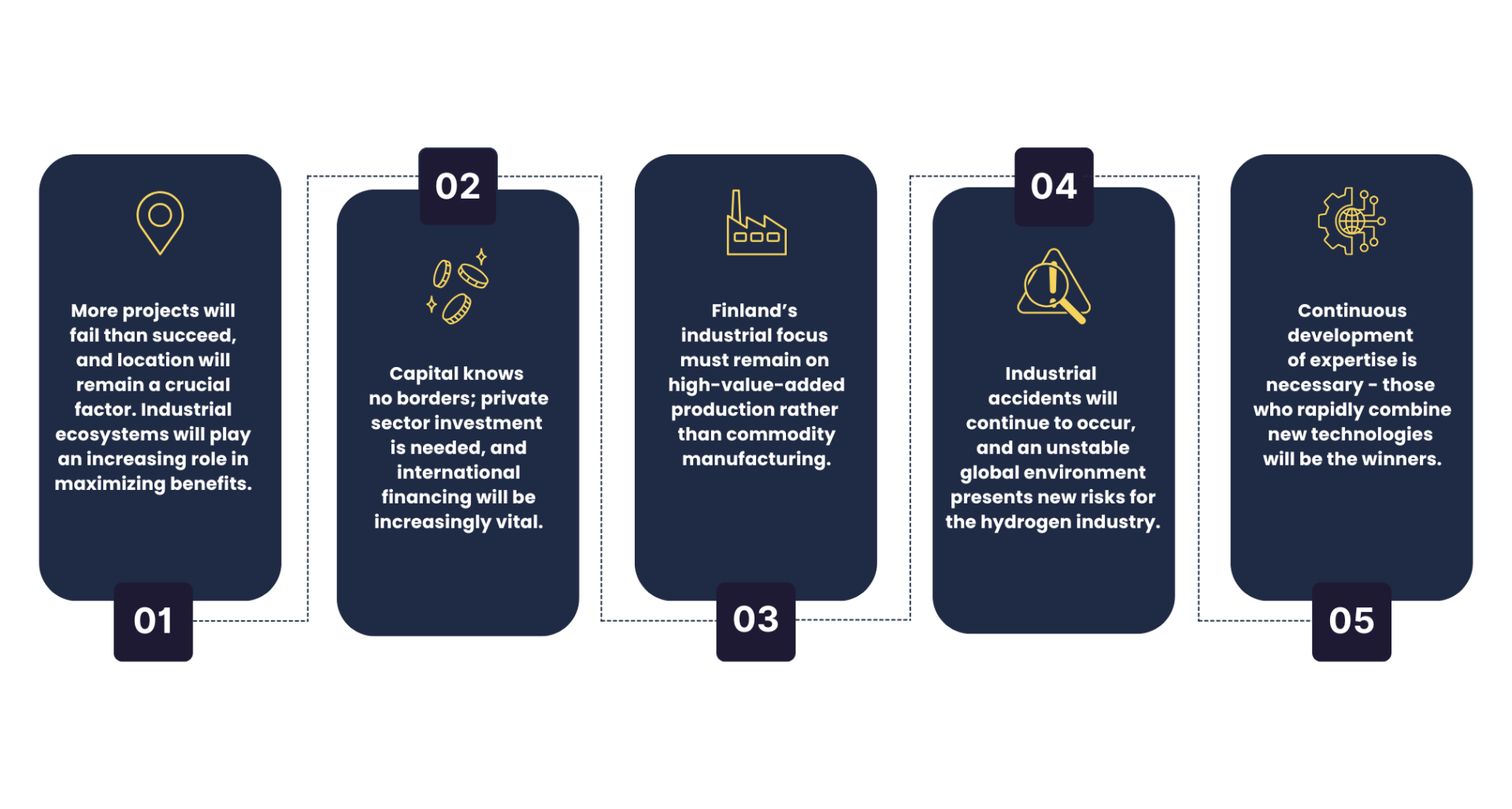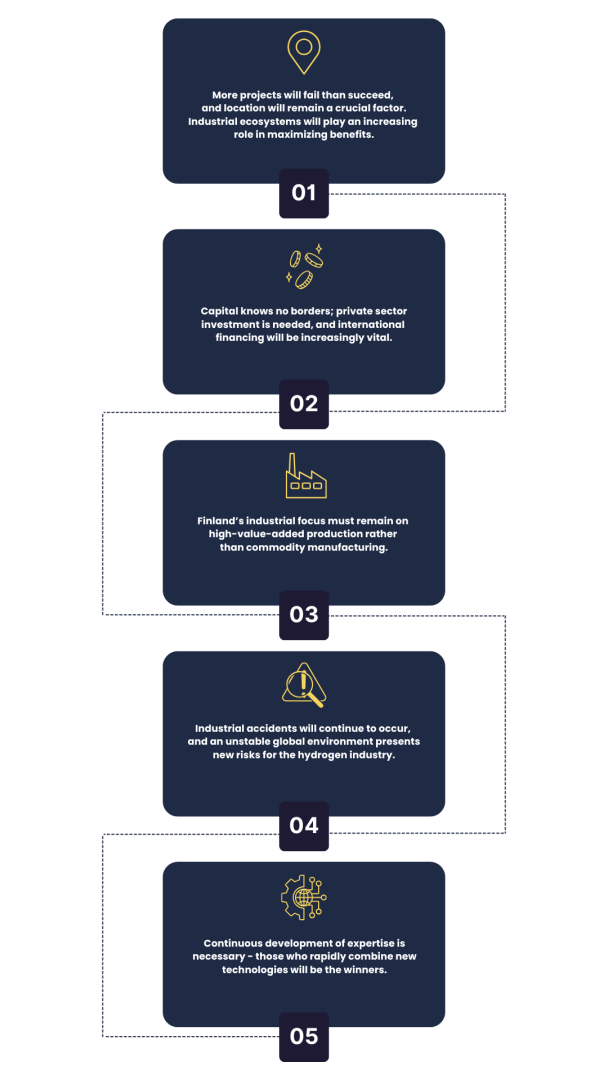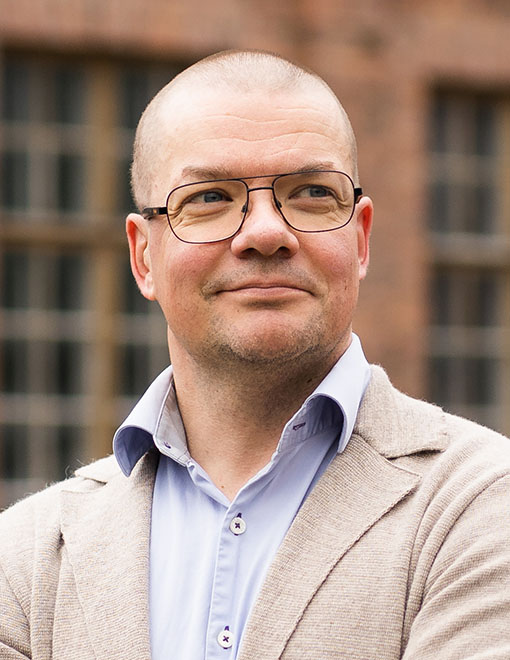10/04/2025
What Can Developers of the Hydrogen Economy Learn from Industrial History?
The hydrogen economy is currently experiencing an interesting phase, as an entirely new industrial sector is emerging, with its key elements still taking shape. This situation is not unprecedented. Similar moments can be found in Finland’s industrial history. In this blog, I examine differences and similarities between the present and the past through various examples.
Location as the key requirement for operations
“Gustav Wrede received permission from the Senate to establish an ironworks in Varkaus in 1815. The reason for placing the ironworks in Varkaus was primarily the good water areas, rapids for power generation, and large nearby forest areas.”
When examining hydrogen economy projects, a suitable location remains the most important requirement for operations. The availability of raw material – now electricity – is essential. Today, permitting authorities and electricity grid operators, led by Fingrid, play the role of the Senate. It is always crucial to remember that the location must facilitate the delivery of the final product to the market, making port environments and potential future hydrogen pipeline hubs particularly attractive sites for production investments.
Project developers are diverse in industrial transitions
“The Pitkäkoski wood grinding and paper mill was established in the village of Ruotila, Sippola, in 1916. It was found to be a good factory site, and the rapids were leased in the name of teacher V.J. Häkli for fifty years. Other company initiators included engineer E. Niinikoski, farmer A. Huovila, CEO J. Vitikainen, and sawmill operator E. Rautaheimo.”
Hydrogen economy investments are also being developed by a wide range of players. Examining the entities behind Finland’s projects reveals regional development companies, municipalities, energy companies, industrial corporations, professional project developers, and various startup actors. These players have different starting points and capabilities for advancing projects to the commercial stage.
Technological advancements ensure efficiency
“The modern industrial facility completed in 1837 at Tampere’s Finlayson area used cast iron columns as load-bearing structures instead of partition walls, allowing production to be carried out in a completely new way. The same building also featured a fire suppression system developed in England, protecting production from the greatest threat of the time – fires.”
The hydrogen economy can benefit from long-established and tested technologies (e.g., Haber-Bosch and Fischer-Tropsch synthesis). At the same time, completely new technologies are needed, especially those suitable for mass production. For example, hydrogen storage and transfer under high pressure still require further technological development. It is also essential to recognize that even well-tested technologies must be optimized to improve efficiency and profitability.
Domestic expertise is available
“Carl von Nottbeck, a key developer of Tampere’s Finlayson factories, graduated from the Technical University of Zurich as a mechanical engineer and later worked at Thomas Edison’s factories in the United States in the late 1870s. There, he became acquainted with the use of incandescent lamps for lighting. Upon returning to Finland in 1881, he, together with Istvan von Fodor, brought electric lighting to Finlayson’s Plevna weaving hall in Tampere.”
In history, technological expertise was almost entirely sourced from abroad, but today, Finland has international-level hydrogen economy expertise and education. Additionally, Finland’s industrial heritage from forest industry investments enables the country to accelerate investments and develop technology efficiently.
An age-old pursuit of creating higher value
“In the 19th century, industrialization started with ironworks and water-powered sawmills, followed by machine shops. This laid the foundation for shipbuilding, and when the Saimaa Canal opened in 1856, it created entirely new higher-value markets in Inner Finland. Similarly, in the 20th century, the forest industry progressed from sawmills to pulp production and eventually to paper manufacturing.”
At the beginning of the 21st century, a similar hydrogen boom emerged, with discussions about hydrogen-powered vehicles. Woikoski even established a hydrogen refueling station. Since then, projects have increasingly focused on higher-value products, such as e-fuels (methanol and eSAF) and green ammonia. At the research level, efforts are being made to develop solutions for synthetic protein production, among others.
Economics and profitability determine success
“A businessman named Matti Roiha wanted to establish a factory in Simpele, so he bought the Juvakoski area. The plan was to build a mill producing rag paper, but the business soon went bankrupt. In 1899, a new company, Oy Atlas, was founded with Roiha as CEO. However, construction halted again in 1902 due to bankruptcy. In 1905, a company named Ab Simpele continued the work, and this time, the first machines were delivered, and production finally began in 1906.”
Similarly, ensuring project profitability remains critical today. For example, Neste announced its withdrawal from a hydrogen investment in Porvoo in 2024 due to challenging market conditions and economic circumstances. New investments require careful consideration, assessing both capital expenditure and operational feasibility.
Safety is crucial
“Röyttä’s sawmill operated in Tornio from 1862 to 1982. Its first phase lasted from 1862 to 1928, ending when a severe fire destroyed the facility. Sawmill operations resumed in 1951 and continued until 1985.”
Ensuring safety is one of the most critical aspects of hydrogen economy projects. The main risks involve high pressures, hydrogen’s explosiveness, and the toxicity of some hydrogen-derived products. While industrial safety has significantly improved, risks still exist. A recent example is the explosion at Venator’s titanium dioxide plant in 2017, which led to its closure.
Geopolitics affects business
“The Crimean War (1853–1856) significantly disrupted traditional trade in tar and timber with Europe, as maritime traffic in the Baltic Sea became difficult. However, Finland’s shipbuilding industry grew during the war, as the country had the capability to build steam frigates needed by the Russian Navy.”
Similarly, today, Russia’s invasion of Ukraine and other global geopolitical movements have created uncertainty in markets and new investments. It is also notable that the Baltic Sea has once again become a geopolitical hotspot, which must be considered when planning regional hydrogen pipelines.
Employment and value chains
“In 1912, Wilh. Schauman’s plywood factory in Jyväskylä’s Lutakko district began production, employing 141 workers by year-end. By 1919, the number of employees had increased to 520, nearly 10% of Jyväskylä’s total population at the time (5,523 inhabitants in 1919).”
In contrast, today’s hydrogen production investments aim to be as automated as possible, meaning their direct employment impact will be modest. However, employment opportunities within the hydrogen economy’s value chain are much more significant.
Lessons from history and a look into the future
Many of the key themes in the hydrogen economy today have been crucial in the past as well. However, new factors have emerged that must be addressed. Key takeaways for the future include:


Sources
- Wikipedia
- Vuokko Lepistö JOKO TEILLÄ ON PRIMUSKEITIN? HT181_opt.pdf;jsessionid=ED0A5DF1F87439AB6A91B2A440B51FEB
- Varkauden teollisuushistoria – Saranat
- Simpeleen tehtaat – Paperiliitto
- Tehdastyö on raskasta – HiMa
- Historiikki.pdf
- TERWAN HISTORIA
- AnnalesC393Auvinen.pdf;jsessionid=6D546773A86F3F27D4EC036F0CA16226
- B_11.pdf;jsessionid=2D13309BDD1C33C91C152C55DF455A22
- Elinkeinoluvat ja talouselämän monipuolistuminen 1800-luvun alun Suomessa | Ennen ja nyt: Historian tietosanomat
- Tietoa_jyvaskylasta_vaestokehitys1837-2017.xlsx
- Jyväs-Helmi Oy: Lutakon historiaa(html, jpeg) Jyväskylä: Jyväs-Helmi Oy.
Pictures
- Fiskarssin ruukki, Ståhlberg K.E., Museovirasto
- Rendering of a hydrogen production facility, Green North Energy
- Koski. Joen varrella metsää. Ranta kivikkoinen., Heikel Matti, Lapin maakuntamuseo
- Finlaysonin kutomosali, Plevna, Vapriikin kuva-arkisto
- Lauritsala, Saimaan kanava, Etelä-Karjalan museo
- Röyttän sahan palo, Kemin historiallinen museo
- Sisäkuva Schaumanin vaneritehtaasta, Keski-Suomen museo
Learn more
Scaling up
We want to accelerate the implementation of industrial projects that promote the bioeconomy and circular economy. A key tool in this work is the scaling model we have developed.
Low-carbon energy and solutions for the hydrogen economy
We carry out various low-carbon energy projects from ideation and consulting all the way to implementation. Our expertise is scalable to meet a variety of needs.

